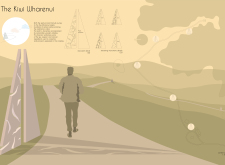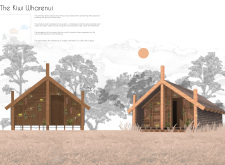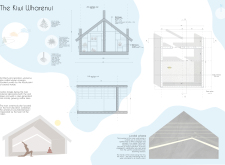5 key facts about this project
The Kiwi Wharenui stands as a thoughtful blend of architecture and cultural significance, located in a setting that highlights both spiritual and ecological values. Designed primarily as a meditation space, it encourages users to connect deeply with nature. Visitors approach a serene inner sanctum via a path lined with wooden obelisks, creating a clear transition from the outside world to a more contemplative environment.
Design Concept
The main idea behind the design emphasizes a gradual entry into tranquility. The pathway, framed by wooden obelisks, directs visitors toward the cabin, helping to prepare them for their reflective journey. This transition is more than physical; it is a mental shift, signaling a move from everyday life into a dedicated space for mindfulness.
Spatial Organization
The entrance area consists of two functional spaces: a terrace and a decorative wall that is used for drying local herbs. This setup shows a commitment to using local plants and integrating the surrounding environment into the experience. The division into a herbarium and a communication area allows guests to mentally and spiritually prepare for meditation before entering the main cabin.
Cultural Significance
Key architectural elements, such as elongated columns and symbolic pillars, connect the structure to ancient traditions. The symmetrical pillar at the front represents the poutokomanawa, or the heart of the cabin, offering both structural integrity and a sense of cultural identity. Visitors can recognize and appreciate the roots from which this space emerges.
Materiality
Cedar shingles serve as the primary material for both the roof and walls, sourced from nearby cedar trees. This choice demonstrates a focus on sustainability and a connection to the local environment. The natural material reinforces the aesthetic while grounding the overall design within its geographical context.
An important feature of the cabin is the main wall, which acts as a sundial. This design element connects the experience of the space to natural time cycles. Visitors engaged in meditation can monitor the passage of time by observing shadows, encouraging a deeper awareness of seasonal changes and rhythms in nature.




















































